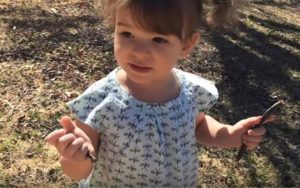A toddler’s brain damage has been reversed over a year after near drowning
By Ariel Scotty, New York Daily News
She’s a survivor.
Eden Carlson’s near-fatal fall into her family pool left her brain damaged in February 2016 — but doctors have now significantly reversed the trauma in the tenacious toddler.
Physicians used a series of oxygen treatments, like hyperbaric oxygen therapy, to significantly reverse the 2-year-old’s brain damage after she was in the water for 15 minutes.
To “wake up” her brain, doctors gave Carlson oxygen at a pressure higher than the general atmospheric pressure — increasing the amount of oxygen in her blood and repairing her damaged tissue in a sealed, pressurized hyperbaric chamber.
“The startling regrowth of tissue in this case occurred because we were able to intervene early in a growing child, before long-term tissue degeneration,” hyperbaric specialist Paul Harch from LSU Health New Orleans said in the case report published by Medical Gas Research.
On the day of the near-drowning, the child’s mother found her, pulled her out and performed CPR until doctors at her local hospital in Fayetteville, Ark., were ultimately able to revive her two hours later after she also suffered cardiac arrest. Her lack of oxygen resulted in a severe brain injury, leaving the child unable to speak, walk or respond to verbal cues.
She was at the hospital for 48 days receiving critical care before being discharged, but Harch wanted to try a course of oxygen therapies to try and help heal Carlson’s brain.
First, she was administered oxygen treatments at “normobaric level” (sea level), 55 days after the accident, for 45 minutes at a time, two times per day which helped her regain movement of her arms and hands, her partial ability to eat and speak in short spurts.
Three weeks later, she was moved to New Orleans — at a hospital in possession of the closest hyperbaric chamber — where the hyperbaric oxygen therapy began.
In just 10 sessions, the toddler’s mother said she was back to “near normal.” Carlson was able to walk and speak even better than before the accident happened. She was markedly improved in all of her neurological, motor function and cognition tests.
An MRI scan 162 days after the incident showed that the child still has mild residual brain injury but the cortical and white matter atrophy she suffered was nearly completely reversed. The doctors cannot say for certain how exactly the oxygen treatments helped such a dramatic reversal of severe brain damage but said that the treatments helped to reduce swelling and encouraged brain cells to survive.
“Although it’s impossible to conclude from this single case if the (combined oxygen therapies) would be more effective than HBOT alone,” Harch said. “In the absence of hyperbaric oxygen therapy, short duration, repetitive normobaric oxygen therapy may be an option until hyperbaric oxygen therapy is available.”



